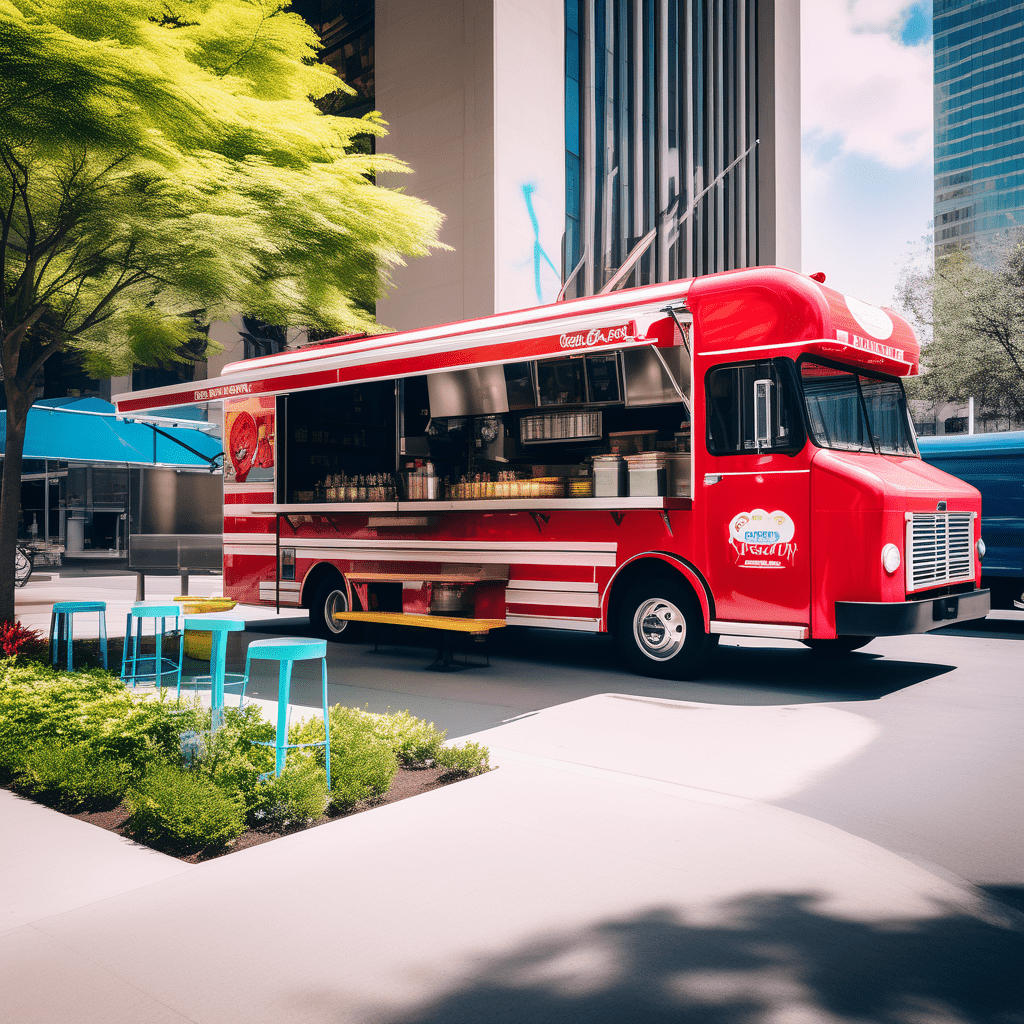
SEO for Food Trucks Rolling into Search Visibility
Introduction
For food truck owners and operators looking to attract hungry customers and increase their presence in the competitive food industry, Search Engine Optimization (SEO) is a powerful tool to enhance visibility, attract foodies, and thrive in the mobile dining market With the rising popularity of food trucks and the growing trend of consumers searching for mobile food options, optimizing for SEO can significantly boost the visibility of food trucks and connect them with a broader audience of food enthusiasts In this comprehensive guide, we will explore the significance of SEO for food trucks and provide actionable strategies to roll into search visibility effectively

1 Identify Your Target Audience and Define Your Food Truck Specialties
The first step in rolling into search visibility is to identify your target audience, such as local residents, tourists, or specific food lovers (eg, vegan, gourmet, etc) Clearly define your food truck specialties, whether you offer gourmet burgers, artisanal tacos, or plant-based cuisine, and showcase it throughout your website and content to resonate with your audience and establish your culinary expertise

2 Optimize Website Content with Relevant Food Truck Keywords
Optimize your website content by incorporating relevant food truck keywords that reflect your menu items, cuisines, and unique offerings Use keyword-rich s, meta descriptions, and headers to improve search discoverability and rank higher in search engine results
Keyword Research: Begin by conducting thorough keyword research to identify terms and phrases potential customers might use when searching for food trucks. Consider variations such as “mobile kitchen,” “street food,” and specific cuisine types. Use tools like Google Keyword Planner for insights into search volumes and competition.
Strategic Placement: Integrate your chosen keywords strategically within your website content. Place them naturally in key areas such as titles, headings, meta descriptions, and throughout the body text. Ensure a balance to maintain readability and user engagement.
Local Focus: Emphasize local keywords to capture your target audience in specific locations. Include the name of your city, neighborhood, or popular local landmarks. This helps your food truck appeal to customers searching for convenient and nearby dining options.
Menu Optimization: Incorporate keywords within your menu descriptions. Be descriptive about the dishes you offer, highlighting unique flavors and ingredients. This not only helps with SEO but also provides potential customers with a mouthwatering preview of your offerings.
3 Create Mouthwatering and Informative Food Truck Content
Create mouthwatering and informative food truck content that showcases your signature dishes, daily specials, and food truck events Use blog posts, food truck videos, and high-quality food photography to captivate potential customers and demonstrate your passion for culinary delights
Irresistible Menu Descriptions: Describe your dishes in a way that sparks curiosity and excitement. Use vivid language to highlight the unique flavors, textures, and aromas of your offerings. Share the inspiration behind each dish to create a connection with your customers.
Captivating Food Photography: Invest in high-quality food photography to showcase your culinary creations. Visual content is powerful and can evoke strong emotions. Ensure that images are well-lit, capturing the details that make your food truck’s offerings stand out.
Behind-the-Scenes Stories: Share behind-the-scenes glimpses into the daily operations of your food truck. Introduce your team, share anecdotes about your culinary journey, and showcase the passion that goes into preparing each dish. This personal touch helps humanize your brand.
Customer Testimonials and Reviews: Feature positive testimonials and reviews from satisfied customers. Highlight their experiences, favorite dishes, and the unique aspects of your food truck that left a lasting impression. This builds credibility and encourages trust among potential customers.
Upcoming Events and Specials: Keep your audience informed about your food truck’s schedule, upcoming events, and special promotions. Whether you’re participating in a local festival, introducing a limited-time menu item, or offering discounts, create buzz around these occasions.
4 Utilize Long-Tail Keywords for Specific Food Searches
Incorporate long-tail keywords into your content to target specific food searches, such as “gourmet food truck in [your city]” or “best tacos near [landmark]” Long-tail keywords can attract highly targeted traffic from hungry customers seeking unique food truck experiences
Understanding Long-Tail Keywords: Long-tail keywords are specific phrases that typically consist of three or more words. Unlike broad keywords, they target a niche audience, providing more detailed information about what your food truck offers. For example, instead of just “food truck,” consider “gourmet taco food truck in [your city].”
Research Your Niche: Identify the unique aspects of your food truck offerings. Whether it’s a specialty cuisine, a signature dish, or a specific dietary focus, conduct research to discover keywords that align with these niche elements. Tools like Google Keyword Planner can assist in finding relevant long-tail keywords.
Incorporate Local Keywords: Since food trucks often operate in specific locations, include local identifiers in your long-tail keywords. This can help you target customers who are looking for food options in a particular neighborhood, city, or region.
Optimize Website Content: Integrate your chosen long-tail keywords organically into your website content. Include them in meta descriptions, headings, and throughout your menu and blog if applicable. This optimization ensures that your food truck website is more likely to appear in search results for specific queries.
Create Content Around Long-Tail Keywords: Develop blog posts, articles, or landing pages that revolve around your selected long-tail keywords. This content can provide in-depth information about your specialty dishes, share behind-the-scenes stories, and showcase the unique aspects of your food truck.
Monitor Performance: Regularly track the performance of your selected long-tail keywords using analytics tools. Evaluate how well they are driving traffic to your website and adjust your strategy accordingly. This iterative process helps you refine your approach based on real data.
Use Long-Tail Keywords in Social Media: Extend your long-tail keyword strategy to your social media channels. Craft captions, hashtags, and posts that incorporate these keywords to increase the discoverability of your content. Social media platforms often contribute to overall search engine visibility.
5 Implement Local SEO for Location-Based Food Truck Searches
For food truck businesses operating in specific locations or events, implement local SEO strategies to optimize for location-based searches Ensure your food truck’s name, address, and contact information are consistent across online directories and utilize Google My Business to enhance your local presence

Google My Business Optimization: Claim and optimize your Google My Business (GMB) listing. Ensure that your business name, address, phone number, and business hours are accurate and consistent across all platforms. Add high-quality images of your food truck, menu items, and the surrounding area to make your listing more attractive.
Local Keyword Integration: Identify and incorporate local keywords into your website content. Include the name of your city, neighborhood, and nearby landmarks. For example, if your food truck is in downtown [Your City], use keywords like “downtown food truck” or “food truck near [Landmark].”
Location-Specific Landing Pages: Create location-specific landing pages on your website. Tailor the content to highlight your presence in different areas, providing details about your schedule, menu offerings, and any special events or collaborations in those locations.
Consistent NAP Citations: Ensure that your business’s Name, Address, and Phone number (NAP) citations are consistent across online directories, review sites, and social media platforms. Consistency in this information is crucial for local SEO credibility.
Local Backlink Building: Build local backlinks by collaborating with other local businesses, food bloggers, and event organizers. Participate in community events and festivals, and seek opportunities for your food truck to be featured in local publications or on community websites.
Mobile-Friendly Website: Optimize your website for mobile users, as people often search for food trucks on their smartphones while on the go. A mobile-friendly site not only provides a better user experience but is also favored by search engines for local searches.
Customer Reviews and Ratings: Encourage satisfied customers to leave positive reviews on your GMB listing and other review platforms. Respond to reviews, both positive and negative, to show that you value customer feedback. Positive reviews contribute to your local SEO ranking
6 Leverage Social Media for Food Truck Promotion
Leverage social media platforms to share your food truck schedule, menu updates, and customer reviews Social media exposure can lead to increased engagement and broaden your reach within the local foodie community
Choose the Right Platforms: Identify the social media platforms that align with your target audience. Popular choices for food trucks include Instagram, Facebook, Twitter, and TikTok. Each platform has its strengths, so select the ones where your potential customers are most active.
Create Compelling Profiles: Optimize your social media profiles with high-quality images of your food truck, a clear and concise bio, and a link to your website or menu. Use your logo or a recognizable image to enhance brand consistency.
Share Mouthwatering Visuals: Post high-resolution images and videos of your delectable dishes. Visual content is key on social media, and mouthwatering visuals can attract attention and create a desire to try your food.
Engage with Your Audience: Actively respond to comments, messages, and mentions. Encourage your followers to share their experiences, tag your food truck in their photos, and participate in polls or Q&A sessions. Engagement builds a sense of community around your brand.
Use Hashtags Wisely: Employ relevant and popular hashtags to increase the discoverability of your content. Create a branded hashtag specific to your food truck, and encourage customers to use it when sharing their experiences. This builds a community around your brand.
Post Regularly and Consistently: Establish a consistent posting schedule to stay on your audience’s radar. Share updates about your location, new menu items, behind-the-scenes content, and any promotions or events. Consistency is key to maintaining an engaged following.
Utilize Instagram Stories and Reels: Leverage Instagram Stories and Reels to share short-lived content, such as daily specials, limited-time promotions, or quick glimpses into your food truck life. These features provide a dynamic and engaging way to connect with your audience.
7 Collaborate with Food Influencers and Event Organizers
Collaborate with food influencers, local food bloggers, and event organizers to amplify your reach and credibility Partnerships can attract more customers and establish you as a reputable and sought-after food truck in the area

8 Utilize Video Content for Food Truck Experience Showcases
Utilize video content to showcase the food truck dining experience, behind-the-scenes preparations, and customer testimonials Video content can provide a more immersive experience for potential customers and showcase your food truck’s unique charm
Create Mouthwatering Visuals: Craft visually appealing videos that highlight the preparation of your signature dishes. Close-up shots of sizzling pans, fresh ingredients, and the final plated masterpiece can evoke a sensory experience for viewers.
Showcase the Food Truck Story: Develop a video that tells the story behind your food truck. Share insights into your culinary journey, the inspiration behind your menu, and the passion that drives your business. Personal narratives create a connection with the audience.
Film Customer Testimonials: Capture genuine reactions and testimonials from satisfied customers. Film short interviews with patrons expressing their favorite dishes, the ambiance of your food truck, and why they keep coming back. Authentic testimonials build trust.
Highlight Specials and Seasonal Offerings: Regularly produce videos to showcase any special menu items, seasonal offerings, or limited-time promotions. These videos can create excitement and urgency, encouraging customers to visit your food truck for exclusive culinary experiences.
Go Behind the Scenes: Take viewers behind the scenes of your food truck operations. Showcase the meticulous preparation of ingredients, the hustle in the kitchen, and the friendly interactions with customers. This provides transparency and authenticity.
Collaborate with Influencers: Collaborate with local influencers to create video content. Influencers can provide unique perspectives, and their videos can reach wider audiences. Consider joint collaborations where influencers try and review your food truck offerings.
9 Showcase Testimonials from Satisfied Food Truck Customers
Showcase testimonials from satisfied food truck customers to demonstrate your mouthwatering food and excellent customer service Testimonials can provide social proof and encourage more foodies to roll into your food truck
Curate Authentic Testimonials: Collect genuine testimonials from satisfied customers. Encourage them to share their honest experiences, highlighting specific dishes, the overall ambiance, or exceptional service they received from your food truck.
Diversify Testimonials: Showcase a diverse range of testimonials that reflect different aspects of your food truck experience. Include testimonials about the variety of dishes, the friendliness of your staff, the speed of service, or any unique features that set your food truck apart.
Utilize Multiple Platforms: Display testimonials on various platforms, including your website, social media profiles, and marketing materials. Consider creating a dedicated section on your website or a designated highlight on Instagram for customer testimonials.
Incorporate Visuals: Enhance the impact of testimonials by including visuals. Feature photos of satisfied customers enjoying their meals or showcase images of their favorite dishes. Visual content adds authenticity and resonates more effectively with potential customers.
Create a Testimonial Video: Take testimonials to the next level by creating a video compilation. Film short clips of customers sharing their experiences, and edit them into a captivating video that can be shared on social media or your website.
10 Monitor Performance and Adapt
Regularly monitor your website’s SEO performance through analytics tools Analyze website traffic, conversion rates, and keyword rankings to refine your SEO strategies and effectively roll into search visibility
Set Key Performance Indicators (KPIs): Clearly define key performance indicators aligned with your business goals. These could include metrics such as daily sales, customer satisfaction scores, social media engagement, or website traffic. Establish benchmarks to measure success.
Use Analytics Tools: Leverage analytics tools like Google Analytics, social media insights, and sales tracking systems to gather quantitative data. Analyze this data regularly to identify patterns, trends, and areas for improvement.
Track Customer Feedback: Actively collect and analyze customer feedback through surveys, reviews, and social media comments. Pay attention to recurring themes or concerns, and use this qualitative data to make informed decisions.
Monitor Social Media Engagement: Track the performance of your social media posts, including likes, shares, comments, and follower growth. Identify the types of content that resonate most with your audience and adjust your content strategy accordingly.
Evaluate Marketing Campaigns: Assess the effectiveness of your marketing campaigns by analyzing conversion rates, click-through rates, and overall campaign reach. Identify successful elements and learn from less successful ones to refine future campaigns.
Review Menu Performance: Regularly review the performance of your menu items. Identify popular dishes and those that may need adjustment or removal. Use sales data and customer feedback to optimize your menu for profitability and customer satisfaction.
Check Event Participation Impact: Evaluate the impact of participating in events and collaborations. Track foot traffic, sales, and social media engagement during and after events. Determine which types of events yield the best results and prioritize participation accordingly.
Assess Customer Loyalty Programs:
Conclusion
Mastering SEO is essential for food trucks to boost search visibility, engage customers, and thrive in the mobile dining scene. Identify your audience, optimize with keywords, and create compelling content. Use long-tail keywords, implement local SEO, and leverage social media. Collaborate with influencers, share video experiences, and showcase customer testimonials. Monitor and adapt your SEO for ongoing success. Elevate your online presence, attract foodies, and become a sought-after destination.
Visit : https://csspmstimes.com/
Visit: https://scholarshipresort.com/
Visit: https://mishitechtalks.com/the-influence-of-computers-on-modern-architecture-and-design/

One Comment